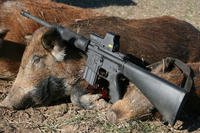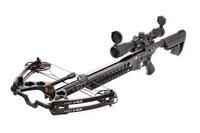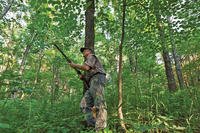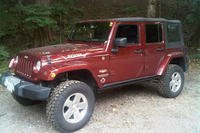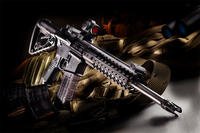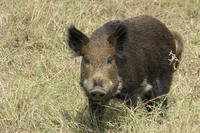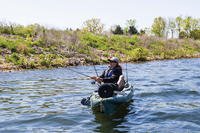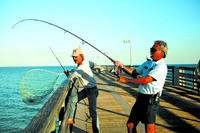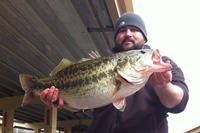Players in this game find that 3 times the gun equals 3 times the fun!
by Bryce M. Towsley
The hottest ticket in competitive shooting today is "3-Gun." It is fast and exciting. It will tax every shooting skill you have with a rifle, handgun, and shotgun, and your shots will range from powder burns on the close targets to so far away the bullet has to pack a lunch for the trip to the target. It's all done against the clock and the shooter who hits all the targets the fastest, wins.
3-Gun is a generic name for this type of action shooting. Some will argue that, technically, in a 3-Gun match, just one firearm type is used during each stage. The term "multi-gun" represents matches where shooters may use two or three types of firearms in a single stage.
The United States Practical Shooting Association (USPSA) regulates some 3-Gun matches, as does International Multi Gun Association (IMGA), but not every match is sanctioned by them. Both have guidelines and rules, but they are not necessarily the governing body for every shoot. Many of the bigger shoots use the basic rules from these organizations, but modify them for their own matches. That flexibility is keeping 3-Gun growing and continuing to be fun. Without a single, governing body claiming control of all the matches, there cannot be one governing body to take all the fun away with rules, regulations, and petty agendas.
This also keeps competitors on their toes. For example, the Tactical Optics division only allows one optic. Most shooters have scopes on their rifles. But, the MGM Iron Man match allows the Tactical Class shooters to have two optics on the rifle. Rather than the usual 1-4X scope common to that class, they can use a high magnification scope and a second optic for the close targets. That's important at this match because they have some long range precision targets. For the second optic most shooters add a red-dot reflex sight mounted on the side so they can turn the rifle and use that sight for close and fast targets. This makes the competitors think about their equipment and keeps them changing things from match to match. In short, 3-Gun doesn't have a fixed set of rules; it is about innovation, change, and surprises.
3-Gun shooting can trace its roots back to the Soldier of Fortune (SOF) matches put on by SOF magazine, starting in the early 1980s and continuing into the '90s. These shoots simulated combat with pistols, rifles, and shotguns and used military or law enforcement (LE) type firearms. From that beginning, the sport has become one of the fastest growing shooting sports in the country. If you love to pull triggers, give this exciting game a try.
As I said earlier, it can encompass long-range precision shooting or ultra close, "hose-them-down" situations - and everything in between - sometimes all in one stage. The action moves fast and will draw on every shooting and gun handling skill you possess. The shooting is "practical" style, which means it simulates combat or self defense. You will be given a "scenario" at each stage that will have you shooting one or more of the guns in a specific sequence. Each stage is different and every match is different. Unlike skeet or bullseye shooting, when you know what the target will be every time you load a gun; in fact it's just the opposite. Each time you step up to a stage it is likely that you will encounter a shooting challenge that is different from any you've shot before. Each shooter must figure out a strategy and hope it's one that wins.
There are several classes and at least a couple of sets of rules. New shooters usually start with the most popular class, Tactical Optics. This class is most likely to fit the firearms you already own. In this class, you're allowed one optical sight and it is almost universally on the rifle.
The handgun and shotgun will not have optical sights. Remember, even if you don't have everything you need to start, if you pool with your buddies, you might find that you do. You can shoot together on the same squad and share firearms. So if you have a rifle, somebody else has a handgun, and another a shotgun, you can all shoot. This gets you started, but be warned, 3-Gun is addictive and you will find yourself buying more guns once you try it. How can that possibly be a bad thing?
Rifles
The rifle segment of 3-Gun is the domain of the AR-15 type rifles. But, that doesn't mean you are required to use an AR. At my first match I saw a party of three sharing one SKS rifle and loading it with 10-round stripper clips. They didn't win, but they sure were having fun! The next time I ran into the guy who owned the SKS, he had a new top of the line competition AR and an addiction to 3-Gun that had him grinning ear to ear. Bottom line, if you have an AR-15 and a couple of 30-round magazines (and who doesn't?) you can start shooting. Even if you do not, most any semi-auto "tactical" rifle will allow you to compete.
When you decide to build or buy a competition rifle, there are a few things that will trick out the rifle in your favor. The .223 Rem./5.56 chambering is king. A muzzle brake is very important if you are going to be competitive. You can shoot well without one, but if you are going to run with the big dogs, sooner or later you will need a muzzle brake. These help manage recoil and reduce muzzle jump for fast, repeat shooting. The barrel length should be 18 to 20 inches. Barrel weight is subject to personal preference, but most prefer a slightly heavy contour to put a little weight out in front and to handle the heat of multiple shots. A 1:9 twist will work, but a 1:8 twist will allow you to use heavier bullets for long-range reactive steel targets.
A good trigger is essential. I like a standard A2 style fixed stock, but a lot of shooters use a collapsible stock because it offers so many options on length of pull to fit different shooting positions that may pop up at different matches. The rifle length gas tube is best because it will allow the use of a long forend. This allows you to reach out on the rifle for better control. Most shooters prefer a round forend as rail type forends will make your hands sore by the end of the day.
Thirty-round magazines are the standard. But you will probably want at least one extended capacity magazine. There are several on the market. Mine is a DPMS 45 round. The 100 round BetaMags see some use, but under International Defense Pistol Association (IDPA), and perhaps other's rules, you must have a "stick" style magazine and drums are not allowed in the Tactical Class. The best optic for most matches is a low power variable. Low-end magnification allows shooting at the very close targets, while the upper end magnification is enough for the long-range shots. The key is versatility and durability. Don't skimp on the optics, as they take a beating and only the toughest survive. Most shooters like a true 1X on the low end so they can shoot with both eyes open. You will probably want an ambidextrous safety, and a tactical bolt catch. This is important because the shooter is often required to clear a rifle and lock the bolt back to make it safe while on the clock. This bolt catch has a big pad to push to lock the action open and keep the "fumble factor" to a minimum. If you fail to lock the bolt back, it's an automatic disqualification in most matches. A tactical, extended charging handle helps with the reloads.
Shotguns
If you already have a semi-auto shotgun you are almost ready to compete. You will need to add an extended magazine. But, that's easy to do and inexpensive. The 12-gauge is the most popular. Often there are reactive steel targets and it provides enough power to knock them down. Some rules require a short barrel, so you will probably replace your bird gun barrel (or entire shotgun) with something more "tactical" down the line. The most common configuration is a semi-auto with a 20- or to 22-inch barrel and an extended magazine that holds eight shots, for a total of a nine-shot capacity, the maximum allowed in Tactical Class. Eventually you will want extra touches like an oversize safety button, extended bolt handle and a larger carrier release. Most shooters like some sort of sights for the slug stages. The key to success in many matches is being able to reload the shotgun fast, so a sidesaddle-ammo carrier is almost a must. This game is tough on a shotgun and only the strong survive. Many guns that have good reputations in the hunting fields can't stand up to the thousands of shots and rough handling of these matches. I know that a Benelli can. After trashing three other shotguns in one year, I went to a Benelli M-2. With two big matches and thousands of practice rounds behind it, the gun has never faltered.
Handguns
You can use just about any semi-auto centerfire handgun to get started. I shot my first match with the gun I use in USPSA, a Kimber 1911 Team Match. But, this is a game designed for high capacity handguns and I quickly discovered the disadvantage of a 10-round magazine. Plus, the recoil of the .45 ACP slowed me down.
I switched to a Glock 34 competition gun in 9mm. This is a high capacity handgun with low recoil and is a good way to get started. Of course, it was only used until Brownell's Tony Barnes completed machining the parts so I could build my custom STI switch-barrel in .40 S&W and 9 mm. The reason for two calibers? 3-Gun is still on the frontier in terms of who regulates and who makes the rules. In many matches there is no power factor to consider and the 9mm is a good choice. The low recoil and high capacity make it very competitive. But, at some matches the various ruling bodies have a power factor requirement and the 9mm is too light to qualify. In that situation, I shoot a .40 S&W. Also, some targets need power. The Iron Man has steel spinner targets that must make a complete revolution to score. My 9 mm was not enough gun, so I am using the .40 S&W this year. The top guys do it with a 9 mm, but I don't have their skills.
Which gun is best? It's hard to say. The 9 mm is the most popular, but a lot of shooters seem to favor the .40 S&W because it's legal in all matches. If you shoot the 9 mm in the matches with a power factor, you lose nothing if you center your hits. But, if you have marginal hits they will score lower than with a more powerful gun.
The most common handgun among today's top shooters is the STI, a high quality, 1911 style high-capacity handgun known for accuracy and reliability. Or you can have Tony at Brownells fit up the parts for you to build one on an STI frame like he did for me.
Other Stuff You Will Need
You will need a way to carry spare ammo, so belt pouches for the handgun and rifle magazines are important somewhere down the road, but don't let the lack of them keep you from your first match. Just stick the mags in your pockets and go. Obviously, you need a holster for your handgun.
It is vital to carry extra rifle magazines in a way that allows them to be accessed quickly, but keeps them secured while running and moving. I use AR-15/M16 Kydex magazine pouches from Brownells.
For the shotgun, you will need plenty of extra ammo available. Tacstar has an inexpensive sidesaddle that will hold six rounds, which is just a start. I have shot in some stages where I used almost 50 rounds. A shell belt will work, but most shooters like belt mounted speed loaders. Also look at arm bands, bandoliers and any other creative way to hold shotshells. I have been using gear from Mark Otto.
You will need to find rifle ammo that is accurate for long range in your gun, so test it. I like a 55-grain Nosler Ballistic Tip load for most of my .223 shooting. For the long-range precision work I might switch to the 69-grain Sierra Match King load. In my rifle, the point of impact for both loads is close enough that I can switch back and forth without adjusting my scope.
For the 9 mm I like 115-grain round nose FMJ. It is inexpensive, runs well in my guns and keeps recoil to a minimum. For the shotgun I use a 11⁄8-ounce target load. My Benelli likes Federal TruBall slugs the best, and that's my first choice for the slug targets. Transporting the guns and ammo is also an issue. The Blackhawk 44-inch weapons case will hold the rifle and short barreled shotgun as well as the pistol in the side pocket. The new 3-Gun Competition case from Brownells is a bit longer and easily accepts a 24-inch barreled shotgun. It also has backpacking straps to help carry the load. Put the ammo in a range bag to carry in your hand and you are good to go.
A much easier way is to use a cart. Mine is from Rugged Gear and is designed to hold three long guns, but I have modified it to hold four. It also carries all the ammo and other gear, including a few water bottles. It's easy to push, even with a full load. Best of all, they are not all that expensive. 1-800-784-4331, www.ruggedgear.com. The best endorsement for 3-Gun is what Bruce Piatt, one of the top shooters in the world, said to me about this game at one of the first matches I ever attended. When asked to describe the sport in one sentence he said: "Three times the guns - three times the fun!"
